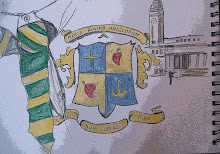Most of the examples here have used the general silhouette shapes of the male and female body to represent which toilet is which. This is easily distinguishable because of the dress that the woman has on and the trousers that the man is wearing. Although they have used the same idea of the silhouette, the actual styles of the design are different. Some are much more linear whereas others have a curve to the design. I personally think that they all work in identifying between the two toilets but I think the best is the design that is the cleanest and simplest one. I particularly like the bottom left designs with the black silhouette shapes on the white background, making the symbols easy to identify as well as standing out on the toilet doors.
The black on white or vice versa certainly stands out better than the example of the black silhouettes being on the brown background. This is not as clear and so would make it harder for the audience to see the signs from a distance as well as it taking some time for the audience to work out which toilet is for which person.
The symbol on the top right appears to be made from chocolate? The style of the design here is much more detailed than the others, which is not necessarily needed when trying to communicate to an audience and simplifying the information for them. I think this is quite humorous in the way that it distinguishes between the male and female by having the detailed drawings of one boy standing up and the girl sitting down. However, in terms of a piece of information design, as you can see from the other examples, creating a design that is simple and clean in appearance works much better and does not need to be so detailed when communicating a simple instruction.



No comments:
Post a Comment